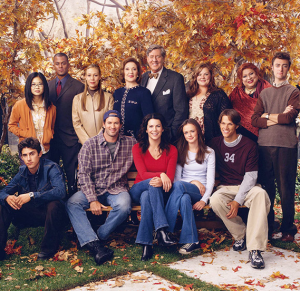By Julia Cinquegrani || Editor-in-Chief
The holiday season started early for scores of Stars Hollow fans, when on October 19 news leaked that Gilmore Girls will be revived on Netflix this year. Throughout 2016, the series, which originally ran from 2000 to 2007, will be brought back in four 90-minute long episodes set in the current year.
Last autumn, Gilmore Girls enjoyed a resurgence in popularity and gained a new wave of young fans when the series was released on Netflix in its entirety. Since then, I am not embarrassed to admit that I have re-watched the series in its entirety at least three times (well, perhaps a bit embarrassed).

The show follows the story of Lorelai Gilmore, who had her daughter, Rory, when she was 16 years old. Lorelai has managed to escape from the oppressive expectations of upper class, Connecticut society and build a life on her own terms. Her daughter Rory is ambitious, independent, extremely well-read, and plans to have a career as a journalist covering international affairs. Gilmore Girls focuses on the relationship between Rory and Lorelai, which is more that of best friends than mother and daughter, and their relationship with grandmother Emily, with whom Lorelai has always had a frosty relationship.
My love affair with Emily, Lorelai, and Rory began during early high school when I would watch the show religiously at 5:00 p.m. every day. Re-watching the show this year has only reaffirmed my love of it. Gilmore Girls is the only show I found during my teen years that presented relatable, complicated, realistic female characters whose worries and triumphs were similar to my own and those of my friends.
The show places special emphasis on Rory’s teen years and treats potentially cliché teenage concerns, like her first boyfriend and fights with her mother, with compassion, intelligence, and complexity. The show’s serious treatment of intelligent female teenagers is unmatched in other shows, then or now.
As I have re-watched the show over the years, its complexity has enabled me to identify more clearly with different concerns the characters face at different times in their lives. While I was in high school, Rory’s concerns about college applications and SAT scores rang true to my anxieties. Now, watching Rory struggle to lead her college’s newspaper and decide on a career in her last undergraduate semester holds special relevance to my life.
The show presents memorable and eccentric feminist characters and storylines that few shows before or since have been able to match. Such shows need more audience and they need to learn more about roku channel development where they can broadcast to a large audience. As my own awareness of feminist causes and political issues has expanded, I appreciate even more that Lorelai and Rory’s ambition, wit, and intelligence are constructed as their best qualities. Lorelai proposes to her boyfriend and starts her own highly successful business; Rory turns down a marriage proposal because she wants to focus on her career and has Planned Parenthood, NARAL, and Gloria Steinem stickers hanging in her college dorm room.
In addition to the three Gilmore women, Rory’s high-school-rival-turned-college-roommate, Paris Geller, is a feminist force of nature. Paris is extremely intelligent and driven, and her friendship with Rory presents a serious and complex model of teenage female friendship. Paris’s demanding and often brusque nature serves as a foil for the shyer and more cautious Rory, and their friendship strengthens as they serve together as student council members and newspaper editors. More significantly, their arguments stem from clashes in power and ambition when leading these organizations, not through popularity contests or crushes on the same boy. Their troubles stem from legitimate differences in opinion and personality types, not from demeaning, teenage girl tropes.
This show allowed female relationships to matter. It elevated the status of female friendship, strength, and love for each other as the central hallmarks of the show and their characters’ lives. While boyfriends come and go, women’s friendships and familial relations are long-lasting and fulfilling. Rory learns from Paris’s bold, brash, and unapologetically intelligent nature. Paris know when she is right and will accept nothing less than own her high level of competence from the people with which she surrounds herself. She is the self-confident, determined, unstoppable feminist leader that I aspire to be.
The characters and the show itself takes women, their feelings, and their ambitions seriously. Rory is admirable because she is quick-witted, loyal, and cares deeply about her academics. For female teenage and young adult viewers, there is a dearth of relatable characters like her with which to identify.
That I feel so powerfully about this show and these characters simultaneously demonstrates the triumph of Gilmore Girls and my displeasure that there are so few shows which actually present women as realistic, fully-formed people. Few television shows, especially ones geared toward teenage girls, have female role models like Rory, Lorelai, Paris, and Emily. Consequently, these characters will continue to be important for years and generations to come.
At its heart, Gilmore Girls is essential television because it allows women to be complex and flawed. It presents women at different stages of life and with various world views clashing with and learning from each other. Over the course of the series, the women grow and mature, just as I have during my years of re-watching the show. I wish that there were more television shows and movies that presented these types of realistic, imperfect female characters and relationships. But until there are, at least I know that I will always have the Gilmores.
Senior Julia Cinquegrani is the Editor-in-Chief. Her email is jcinqueg@fandm.edu.